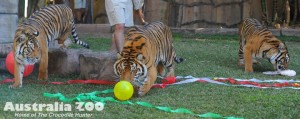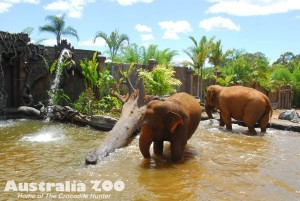Brief History
Lyn and Bob Irwins’ love for nature and wildlife drove the couple to start Beerwah Reptile and Fauna Park in Sunshine Coast, Queensland. Opened on 3 June, 1970, the four-acre wildlife park was home to native Australian wildlife animals such as Lace Monitors, Tiger Snakes, Freshwater Crocodiles, Magpie Geese and kangaroos.
By the 1980s, the wildlife park had expanded twice its initial size to eight acres and was renamed Queensland Reptile and Fauna Park. In 1987, Bob Irwin established the Crocodile Environmental Park, as part of the wildlife park, to protect Saltwater Crocodiles.
In 1991, Steve took over his parents in the ownership and management of the zoo, and later renamed it Australia Zoo. Steve and his wife, Terri, dedicated their time to bettering the zoo, launching and joining more conservation projects.
For the past consecutive years since 2002, Australia Zoo has been honoured a top tourist attraction of Australia. Additionally, in 2003, the zoo won the Gold Award National Trust Queensland for its remarkable conservation efforts.
Even though Steve has since passed on in 2006, Terri and their children, Bindi and Robert, continue to live Steve’s dream and passion for wildlife conservation through Australia Zoo. To date, Australia Zoo occupies 1500 acres and is home to over 1000 native and exotic animals!
Sights:
- Crocoseum
Retrieved from http://www.australiazoo.com.au/
Steve always had an ardent desire to build a Crocoseum, where he could share with the public the amazing abilities of crocodiles, and how they live and behave in the wild. Hopefully, through this, visitors could gain a better understanding and appreciation for these often feared and “scary-looking” reptiles. However, this meant that the crocodiles must be observed in clean waters rather than in the usual murky waters they live in to camouflage themselves; that would require much detailed planning and complex infrastructure. Undeterred, Steve opened the Crocoseum in 2004, an arena where spectators could see the crocodiles visibly in the clear water pond during crocodile shows. - Africa
Retrieved from www.sunshinecoast.com
Steve has always envisioned building an African Safari park in his zoo, where visitors could watch animals wandering around freely, like in the wild. He hoped this would develop a greater appreciation and attachment to wildlife and its conservation. A swap of land between the zoo and the Australian government in 2007 enabled Steve’s dream of a safari park to be realised. Opened in 2011, Africa presented the public an exceptional experience with wildlife. Via state-of-the-art walk-through enclosures, visitors could enjoy watching multi-species – giraffes, zebras and rhinos – all interacting and living together on an open plain. Additionally, rescued Queensland Bottle Trees were used to replicate the African Savannah environment.
“We’re really excited because we really are carrying on in my dad’s footsteps. Dad was so excited to one day open Africa and we are! So, we’re carrying on where he left off.”
– Bindi Irwin - The Tiger Temple
Retrieved from www.australiazoo.com.au
Opened in 2005, The Tiger Temple was a perfect home for the Sumatran and Bengal Tigers to live in. Steve did not want the tigers to be caged up as mere exhibits of the zoo, eventually losing their hunting abilities. Thus, in The Tiger Temple, tigers were encouraged to jump, climb and chase after toys, for their stimulation and enrichment. Additionally, as tigers love splashing around in water, The Tiger Temple has a water pool for them to play in. Through their interactions with the handlers during play time and pool time, the tigers learn to respect their handlers, and vice-versa, thus nurturing a human-animal bond. The Tiger Temple allows visitors to see the tigers up-close in water and on dry land, through glass panels. This gives viewers a perfect chance to observe the tigers’ natural behaviours in the wild, and deepens their affection for these majestic cats.
- Elephantasia
Retrieved from www.australiazoo.com.au
Opened in 2006, Elephantasia is the largest elephant enclosure in Australia. Elephants here can move around comfortably in water and tropical gardens, while being viewed by visitors.




